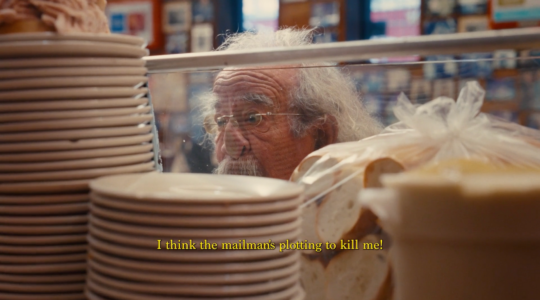In the cultural history of the second half of the 20th century, few figures — and no Jews — are more influential or pivotal than Bob Dylan.
No other artist bestrides so many trends and streams of Americana; Dylan merges folk, blues, gospel, country, rock and modernist poetry (with strong ties to the Symbolists and Surrealists). And in his relentless shape-shifting and self-reinvention he is an archetype for the age of mass communications.
Oh, yeah, he also writes great, hard-rocking songs, and plays guitar, keyboards and harmonica effectively, and makes the most of an expressive but unlovely singing voice.
If you find yourself echoing Dylan’s own words, “I don’t believe you,” then you need to see two films from this year’s New York Film Festival — Todd Haynes’ energetic and inventively unconventional biopic, “I’m Not There,” and Murray Lerner’s stirring anthology of concert footage, “The Other Side of the Mirror: Bob Dylan, Newport, 1963-1965.” At the very least, these two movies will convince you that Dylan is one of the most protean, mercurial and fascinating figures in pop culture in our lifetimes.
As practically everyone seems to know by now, Haynes’ film divides Dylan’s life into six personae, each represented by a different actor. We see Dylan progress in fragments from a 12-year-old African-American boy (the wonderfully serious Marcus Carl Franklin) through a soft-spoken poet (Ben Wishaw), an earnest folkie (Christian Bale) who eventually is reborn as a Christian preacher, a troubled actor, father and husband (Heath Ledger), a snarky pop star (Cate Blanchett) and a mellowed outlaw (Richard Gere). For each of these aspects of Dylan, Haynes devises a different visual style, ranging from the black-and-white faux cinema-verite of the Blanchett sequences to the amber twilight of the Gere passages.
By all rights, this should feel and be gimmicky, even foolish. But Haynes invests each of his “Dylans” with a powerful interiority that is the perfect counterpart to the music of each period in Dylan’s career, and at the same time links all the personae to a central humanity. In its own oddball way, “I’m Not There” is among the best pieces of music criticism on the subject of Bob Dylan. It’s a jigsaw puzzle of a film, with its various pieces scattered around the table by a deft, if quirky hand. It’s a film that rewards close attention and deserves repeated viewings.
The film’s one significant omission is the place of Judaism in Dylan’s life. I asked Todd Haynes about that gap and he replied, “That is the most secret and well-preserved of his personae. I think Dylan’s relationship to his Jewishness is much more private than any of the other roles he has played, it’s kept close to his relationship with his family life and I don’t think we’re supposed to know more about it than that.”
Murray Lerner has been filming great pop music performances for several decades now and in recent years he has begun to make the results more widely available for both theatrical and home video use. The Dylan film is centered on the singer-songwriter’s appearances at the 1963 and 1965 Newport Folk Festivals. Each of those performances represents a pivotal moment in Dylan’s career. The first is his coronation as the “king of the protest singers,” a label that Haynes makes clear Dylan loathed. The second performance is one of the most famous of Dylan’s career, the moment when he first played with an electric band, tossing aside the too-heavy crown of folksong royalty in exchange for the colorful robes of rock-and-roll prophet. In short, if you wanted to see two early Dylan performances preserved, these would be on the short list.
Lerner’s method is utter simplicity. He plants the camera where it can see the performer, usually just far enough away that you can see him in the larger physical context of the stage, cuts to different camera angles sparingly, never imposing his own rhythmic choices on the music, and shows us audience reactions only between numbers. The result is an intense focus on the artist as creation takes place and, in this case, the results are compelling.
I am not now and have never been that big a fan of the early folkie Dylan, although watching him hypnotize a huge outdoor audience in 1963 is impressive. For me the golden age starts when he and Michael Bloomfield plug in their amps, and the booing that is unmistakably present on the soundtrack is merely confirmation that Dylan had chosen, not for the first time or the last, to shake the dust of idolatry from his shoes to venture into new territories. If it did nothing but save Bloomfield’s scorching obligatti behind Dylan on “Maggie’s Farm,” “Other Side” would be worth seeing; as it is, the film is a jolt of adrenaline straight to the heart.
Two weeks ago in these pages, I remarked on the prevalence of Jewish filmmakers with films about dysfunctional families in this year’s festival. As you might expect from Noah Baumbach, the writer-director of “The Squid and the Whale,” “Margot at the Wedding,” his new film, is another comedy-drama of family gone thermonuclear. Margot (Nichole Kidman) is a successful writer who is estranged from her once-favorite sister, Pauline (Jennifer Jason Leigh). Now that Pauline is marrying an overage slacker (Jack Black), Margot decides to reassert herself in their relationship by turning up for the wedding with her 12-year-old son Claude (Zane Pais).
The result is predictably disastrous, with endless recriminations, replaying of old hurts and the accumulation of new ones. Baumbach is a not uninteresting writer, but he is too close to his material here (and in the previous film) to allow the film to breathe. His visual style is a stolid mix of cross-cutting close-ups and hand-held point-of-view shots, and the film is disappointingly acted, with the honorable exceptions of John Turturro in a brief role as Margot’s husband, who she is abandoning, and Leigh who is nothing less than brilliant as Pauline, a wounded doe with some fight left in her.
Support the New York Jewish Week
Our nonprofit newsroom depends on readers like you. Make a donation now to support independent Jewish journalism in New York.
The 45th New York Film Festival continues through Oct. 14. “The Other Side of the Mirror: Bob Dylan, Newport, 1963-1965” will be screened at the Walter Reade Theatre (70 Lincoln Center Plaza) on Saturday, Oct. 13 at 2 and 9:30 p.m. For information, go to www.filmlinc.com.
“I’m Not There” opens at Film Forum (209 W. Houston St.) on Nov. 21. For information, go to www.filmforum.org or call (212) 727-8110.
“Margot at the Wedding” will open on Nov. 16 at theaters to be announced.
The New York Jewish Week brings you the stories behind the headlines, keeping you connected to Jewish life in New York. Help sustain the reporting you trust by donating today.




